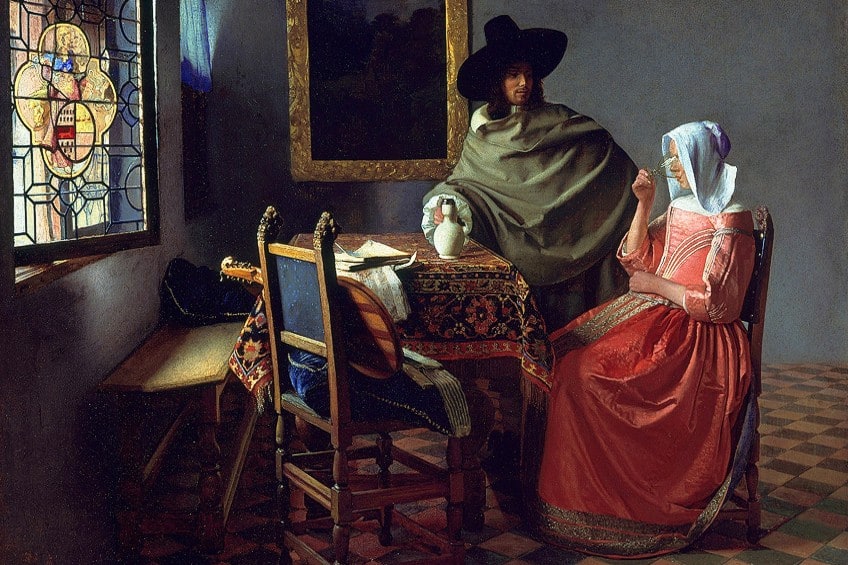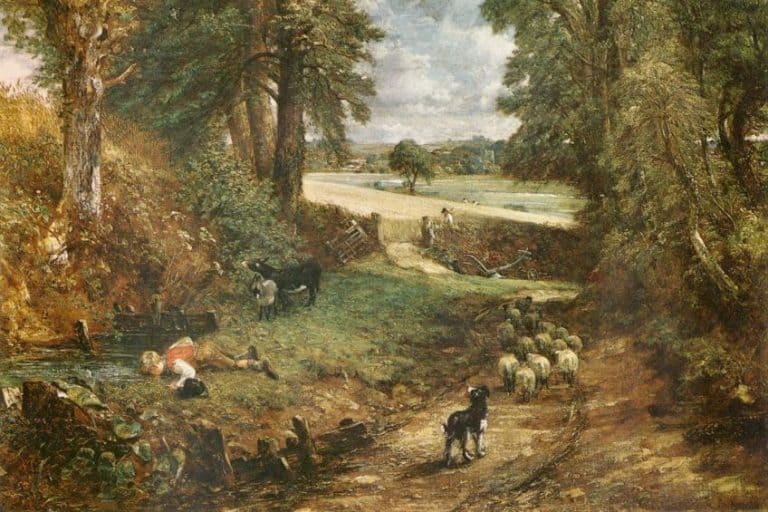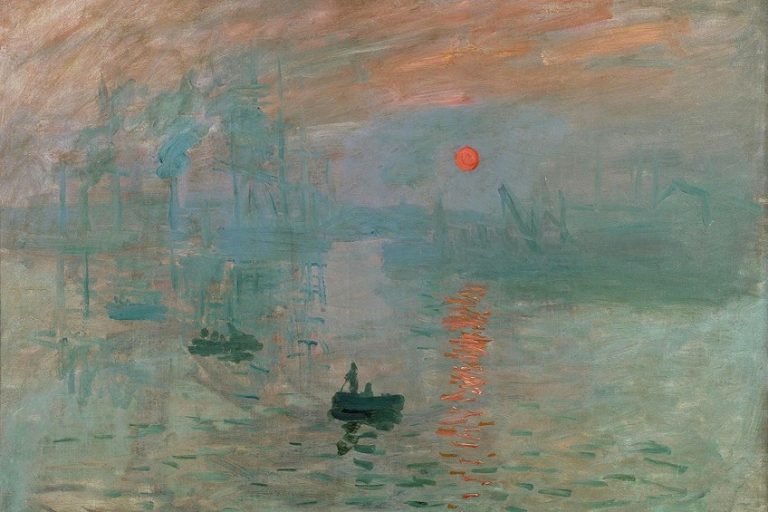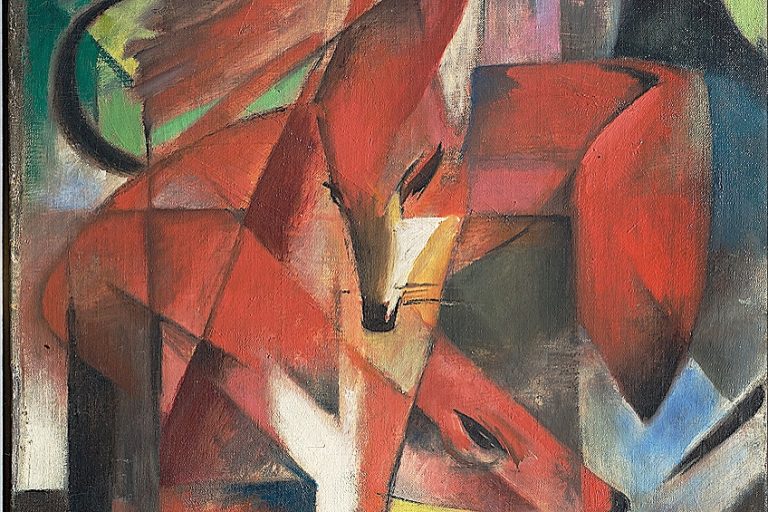Jan Vermeer Paintings – A Look at Vermeer’s Top 13 Works
Jan Vermeer, a master of 17th-century Dutch painting, is renowned for his exquisite portrayal of light, domestic scenes, and meticulous attention to detail. His paintings, characterized by a sense of tranquility and intimacy, invite viewers into a world of timeless elegance and subtle narratives. From the captivating play of light in Girl with a Pearl Earring to the quiet contemplation in The Milkmaid, Vermeer’s works continue to captivate art lovers and scholars alike, leaving an indelible mark on the history of art. Join us on a journey through some of Vermeer’s most iconic masterpieces, where every brushstroke tells a story of beauty and depth.
The Influence of Jan Vermeer
Johannes Vermeer’s influence on the art world is remarkable, considering the limited number of works attributed to him. Despite producing only around 35 known paintings during his lifetime, Vermeer’s mastery of light, composition, and narrative depth has had a lasting impact on art history.
His ability to transform ordinary scenes into captivating works of art, infused with a sense of intimacy and emotion, set a standard for realism and storytelling that continues to inspire artists today.
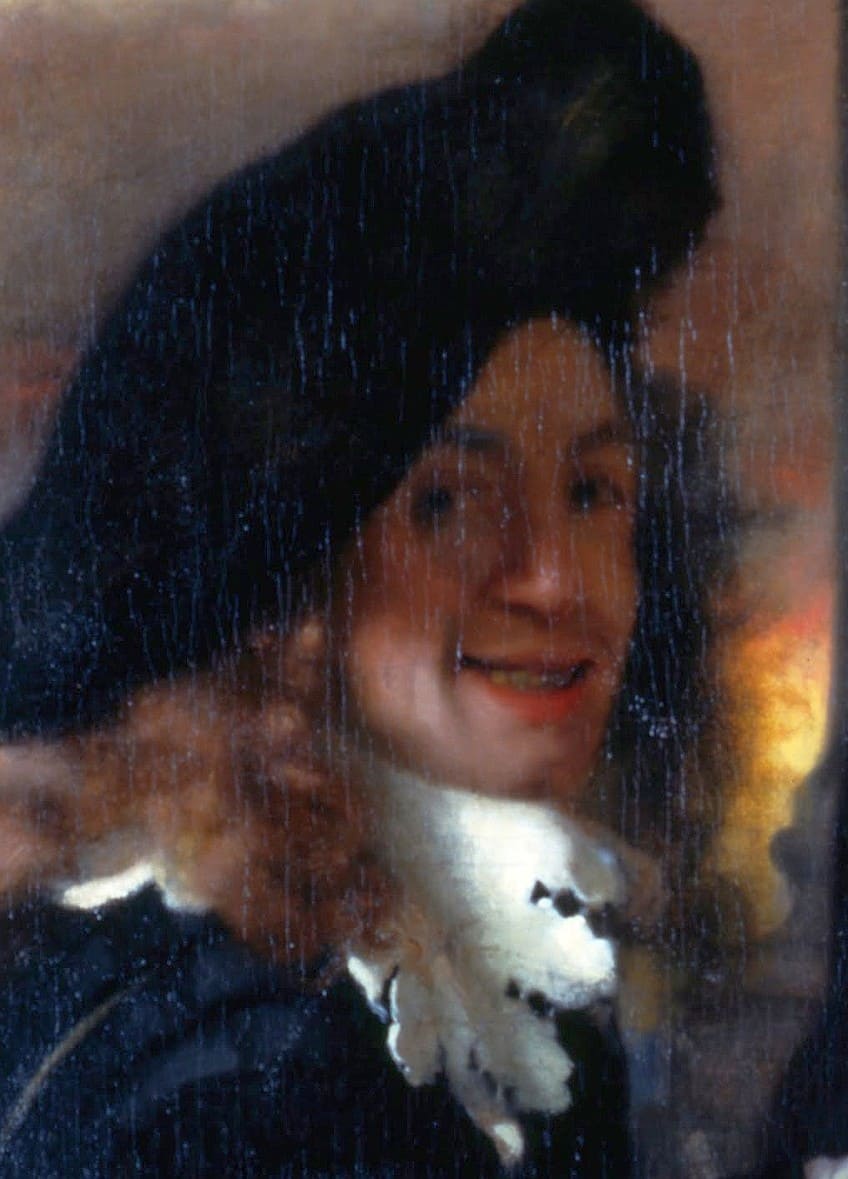
Vermeer’s legacy lies not only in his technical brilliance but also in his unique approach to capturing moments of everyday life. His paintings, such as The Art of Painting and View of Delft, reveal a deep understanding of human nature and a keen observation of the world around him. Vermeer’s legacy endures through his timeless works, which continue to captivate viewers with their beauty, depth, and enduring relevance in the art world.
Top 13 Jan Vermeer Paintings to Know
Vermeer, a celebrated artist of the Dutch Golden Age, crafted a body of work that continues to captivate audiences with its exquisite detail, mastery of light, and timeless narratives. From intimate domestic scenes to luminous portraits, these paintings showcase Vermeer’s unique ability to infuse ordinary moments with profound beauty and emotion. Join us on a journey through some of Vermeer’s most iconic and revered works, each offering a glimpse into the artist’s unparalleled skill and artistic vision.
Diana and Her Companions (c. 1655 – 1656)
| Date | c. 1655 – 1656 |
| Medium | Oil on canvas |
| Dimensions (cm) | 98.5 × 105 |
| Where Is It Housed? | Mauritshuis, The Hague, Netherlands |
This painting depicts a scene from Roman mythology, where Diana, the goddess of the hunt, is surrounded by her companions. Vermeer’s attention to detail is evident in the lush landscape and the intricate rendering of the figures’ garments. The use of light and shadow creates a sense of depth and drama, enhancing the mystical atmosphere of the scene.

The Little Street (c. 1657 – 1658)
| Date | c. 1657 – 1658 |
| Medium | Oil on canvas |
| Dimensions (cm) | 54.3 × 44 |
| Where Is It Housed? | Rijksmuseum, Amsterdam, Netherlands |
One of Vermeer’s rare outdoor scenes, The Little Street portrays a tranquil street in Delft, Netherlands. The meticulous depiction of the houses, cobblestones, and everyday activities of the residents reflects Vermeer’s skill in capturing the beauty of ordinary life.
The painting’s simplicity and harmony convey a sense of domestic serenity and timeless charm.

The Milkmaid (c. 1657 – 1658)
| Date | c. 1657 – 1658 |
| Medium | Oil on canvas |
| Dimensions (cm) | 45.5 × 41 |
| Where Is It Housed? | Rijksmuseum, Amsterdam, Netherlands |
This masterpiece showcases a maid pouring milk into a bowl, set against a plain background. Vermeer’s meticulous rendering of light and texture, especially in the details of the maid’s clothing and the reflective surfaces, elevates the mundane task to a moment of quiet beauty and contemplation. The Milkmaid is celebrated for its realism and the emotional depth it conveys through a simple domestic scene.

Girl Reading a Letter at an Open Window (c. 1657 – 1659)
| Date | c. 1657 – 1659 |
| Medium | Oil on canvas |
| Dimensions (cm) | 83 × 64.5 |
| Where Is It Housed? | Gemäldegalerie Alte Meister, Dresden, Germany |
In this painting, a young woman stands by an open window, engrossed in reading a letter. The play of light on her face and the delicate rendering of the textures, such as the curtain and the map on the wall, demonstrate Vermeer’s mastery of capturing atmosphere and emotion.
The painting invites viewers to ponder the narrative behind the scene and the woman’s inner thoughts.

The Girl with the Wine Glass (c. 1659 – 1660)
| Date | c. 1659 – 1660 |
| Medium | Oil on canvas |
| Dimensions (cm) | 78 × 67 |
| Where Is It Housed? | Herzog Anton Ulrich Museum, Braunschweig, Germany |
This artwork features a young woman holding a wine glass, possibly engaged in a toast or a moment of leisure. Vermeer’s careful attention to detail, from the reflection in the glass to the intricate patterns on the woman’s dress, showcases his skill in capturing textures and surfaces. The painting exudes a sense of refinement and elegance, inviting viewers to appreciate the beauty in everyday moments.
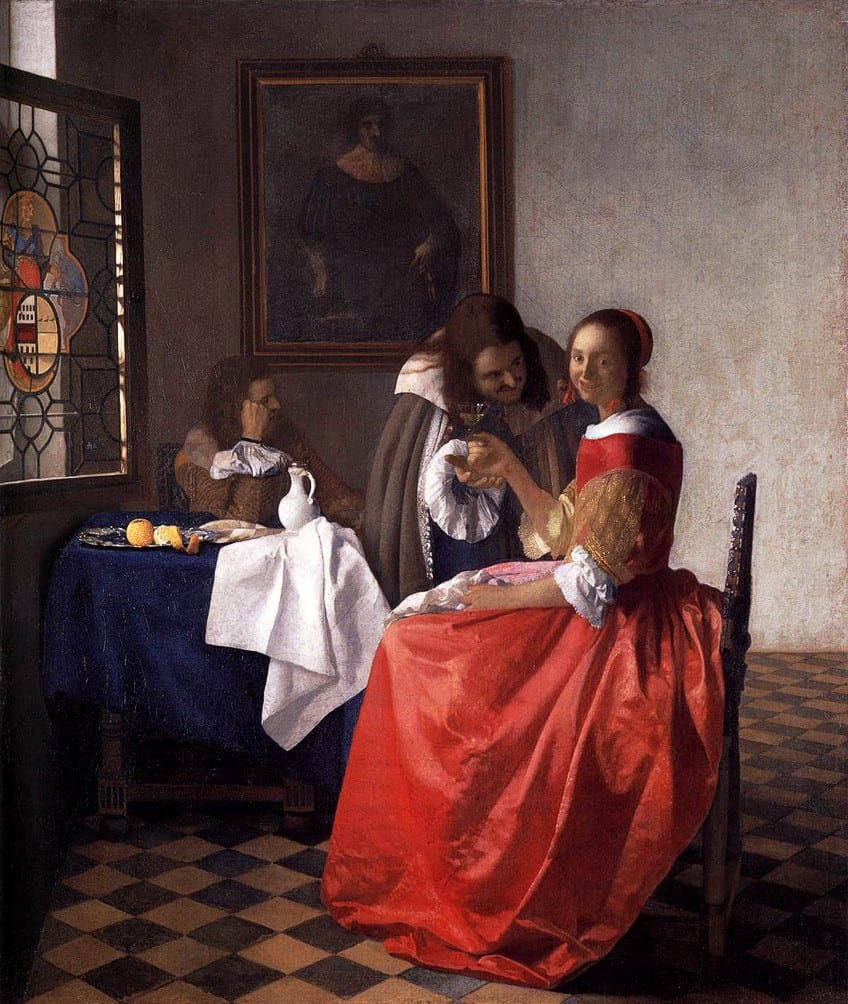
The Glass of Wine (c. 1660)
| Date | c. 1660 |
| Medium | Oil on canvas |
| Dimensions (cm) | 66.3 × 76.5 |
| Where Is It Housed? | Gemäldegalerie, Berlin, Germany |
This painting portrays a woman holding a glass of wine while engaged in conversation, a common motif in Dutch genre painting. Vermeer’s use of light and shadow creates a sense of intimacy, emphasizing the woman’s contemplative expression.
The attention to detail in the textures of the woman’s dress and the reflective surfaces adds depth to the composition, inviting viewers to appreciate the quiet elegance of the scene.
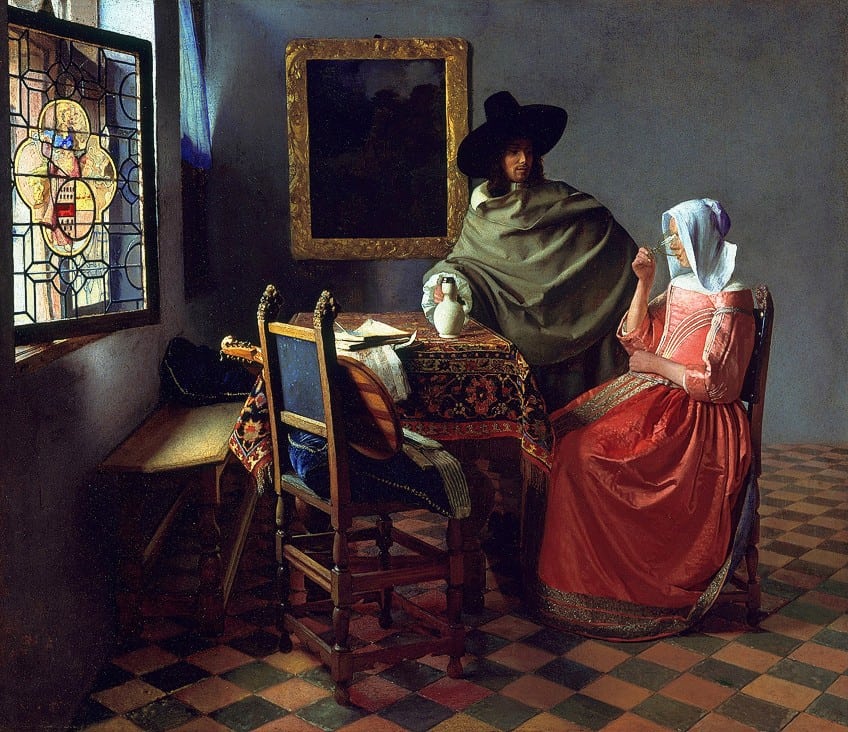
View of Delft (c. 1660 – 1661)
| Date | c. 1660 – 1661 |
| Medium | Oil on canvas |
| Dimensions (cm) | 96.5 × 117.5 |
| Where Is It Housed? | Mauritshuis, The Hague, Netherlands |
Considered one of Vermeer’s masterpieces, View of Delft is a panoramic cityscape capturing the skyline of Delft, Netherlands. The painting’s meticulous detail and the nuanced play of light on the buildings and water demonstrate Vermeer’s skill in creating atmospheric effects. The inclusion of figures and boats adds a sense of life and activity to the serene vista, making it a captivating portrayal of urban landscape.

Woman with a Water Jug (c. 1660 – 1662)
| Date | c. 1660 – 1662 |
| Medium | Oil on canvas |
| Dimensions (cm) | 45.7 × 40.6 |
| Where Is It Housed? | Metropolitan Museum of Art, New York City, United States |
In this work, a woman is depicted pouring water from a jug into a basin, set against a plain background. Vermeer’s focus on the woman’s daily task and the subtle interplay of light and shadow imbues the scene with a sense of quiet grace.
The painting’s simplicity and realism highlight Vermeer’s ability to elevate ordinary moments into timeless works of art.
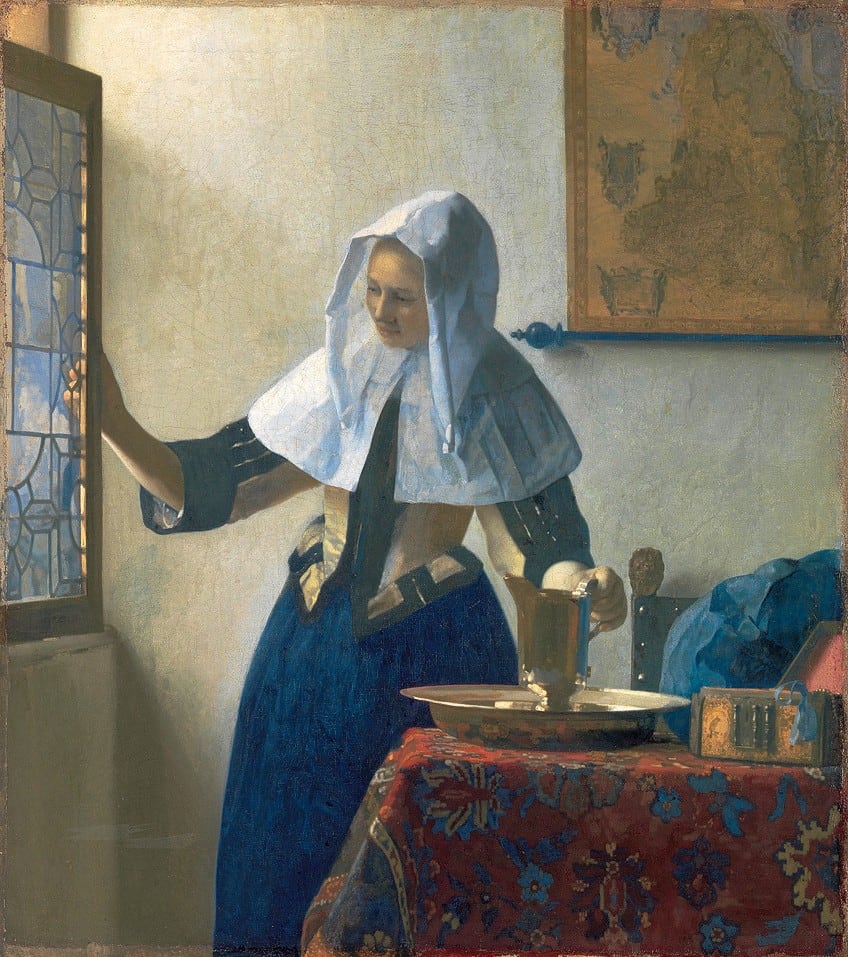
Woman Holding a Balance (c. 1662 – 1663)
| Date | c. 1662 – 1663 |
| Medium | Oil on canvas |
| Dimensions (cm) | 42.5 × 38 |
| Where Is It Housed? | National Gallery of Art, Washington D.C., United States |
This iconic painting features a woman holding a balance scale, symbolizing themes of morality and virtue. Vermeer’s use of light to illuminate the woman’s face and the symbolic elements in the composition adds depth to the allegorical narrative. The painting’s rich symbolism and exquisite execution make it a compelling exploration of themes related to judgment and introspection.

The Music Lesson (c. 1662 – 1665)
| Date | c. 1662 – 1665 |
| Medium | Oil on canvas |
| Dimensions (cm) | 74.6 × 64.1 |
| Where Is It Housed? | Royal Collection, London, United Kingdom |
In this intimate scene, a young woman receives a music lesson from a gentleman in a sunlit room. Vermeer’s meticulous attention to detail, from the musical instruments to the textures of the clothing and furniture, creates a sense of realism and harmony.
The interplay of light and shadow enhances the tranquil atmosphere, inviting viewers to appreciate the beauty of music and domestic life.

Girl with a Pearl Earring (c. 1665)
| Date | c. 1665 |
| Medium | Oil on canvas |
| Dimensions (cm) | 44.5 × 39 |
| Where Is It Housed? | Mauritshuis, The Hague, Netherlands |
This iconic painting features a young woman with a mesmerizing gaze, adorned with a large pearl earring. Vermeer’s use of light to illuminate the woman’s face and the subtle play of shadows adds a sense of depth and mystery to the portrait. The enigmatic expression of the girl and the intricate details of her attire, especially the luminous pearl, have made this painting one of Vermeer’s most celebrated works.

The Art of Painting (c. 1666 – 1668)
| Date | c. 1666 – 1668 |
| Medium | Oil on canvas |
| Dimensions (cm) | 120 × 100 |
| Where Is It Housed? | Kunsthistorisches Museum, Vienna, Austria |
This ambitious masterpiece portrays an artist at work, believed to be a self-portrait of Vermeer. The painting captures the process of creating art, with symbolic elements such as the map, the curtain, and the allegorical figures.
Vermeer’s use of perspective and composition, along with his skillful rendering of textures and light, elevates The Art of Painting to a profound exploration of the nature of art and creativity.

The Astronomer (c. 1668)
| Date | c. 1668 |
| Medium | Oil on canvas |
| Dimensions (cm) | 51 × 45 |
| Where Is It Housed? | Louvre Museum, Paris, France |
This painting depicts a scientist studying a celestial globe, symbolizing the pursuit of knowledge and understanding of the universe. Vermeer’s attention to detail in the scientific instruments and the scholarly atmosphere of the room reflect the scientific advancements of the time. The Astronomer is praised for its combination of scientific accuracy and artistic elegance, showcasing Vermeer’s ability to infuse intellectual themes into his paintings.

Jan Vermeer’s paintings stand as timeless masterpieces that showcase his unparalleled skill in capturing moments of everyday life with extraordinary precision and emotion. His mastery of light, composition, and storytelling continues to inspire artists and enchant viewers centuries after they were created. Whether it’s the serene atmosphere of The Art of Painting, the contemplative mood of Woman Holding a Balance, or the domestic charm of The Love Letter, Vermeer’s works remind us of the enduring power of art to transcend time and speak to the universal human experience.
Frequently Asked Questions
How Many Paintings Did Johannes Vermeer Create During His Lifetime?
Johannes Vermeer is known to have created around 35 paintings that are attributed to him with certainty. However, the exact number may vary slightly depending on scholarly debates and attributions.
What Techniques Did Vermeer Use in His Paintings to Achieve Realism and Depth?
Vermeer employed techniques such as the use of camera obscura, precise application of light and shadow (chiaroscuro), and meticulous rendering of textures to achieve realism and depth in his paintings, creating lifelike scenes that resonate with viewers.
What Makes Vermeer’s Paintings Unique Compared to Other Artists of His Time?
Vermeer’s paintings are renowned for their meticulous attention to detail, mastery of light and shadow, and the ability to capture ordinary moments with a sense of poetry and emotion, setting him apart as a master of the Dutch Golden Age.
Isabella studied at the University of Cape Town in South Africa and graduated with a Bachelor of Arts majoring in English Literature & Language and Psychology. Throughout her undergraduate years, she took Art History as an additional subject and absolutely loved it. Building on from her art history knowledge that began in high school, art has always been a particular area of fascination for her. From learning about artworks previously unknown to her, or sharpening her existing understanding of specific works, the ability to continue learning within this interesting sphere excites her greatly.
Her focal points of interest in art history encompass profiling specific artists and art movements, as it is these areas where she is able to really dig deep into the rich narrative of the art world. Additionally, she particularly enjoys exploring the different artistic styles of the 20th century, as well as the important impact that female artists have had on the development of art history.
Learn more about Isabella Meyer and the Art in Context Team.
Cite this Article
Isabella, Meyer, “Jan Vermeer Paintings – A Look at Vermeer’s Top 13 Works.” Art in Context. March 19, 2024. URL: https://artincontext.org/jan-vermeer-paintings/
Meyer, I. (2024, 19 March). Jan Vermeer Paintings – A Look at Vermeer’s Top 13 Works. Art in Context. https://artincontext.org/jan-vermeer-paintings/
Meyer, Isabella. “Jan Vermeer Paintings – A Look at Vermeer’s Top 13 Works.” Art in Context, March 19, 2024. https://artincontext.org/jan-vermeer-paintings/.


